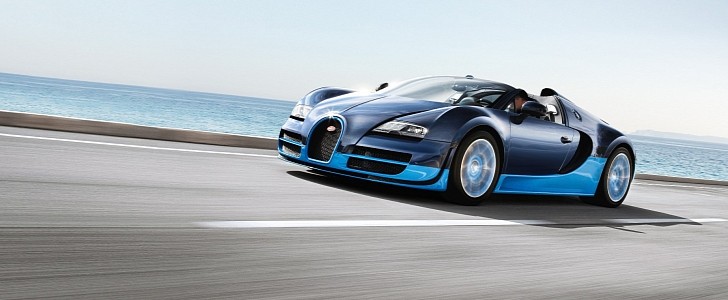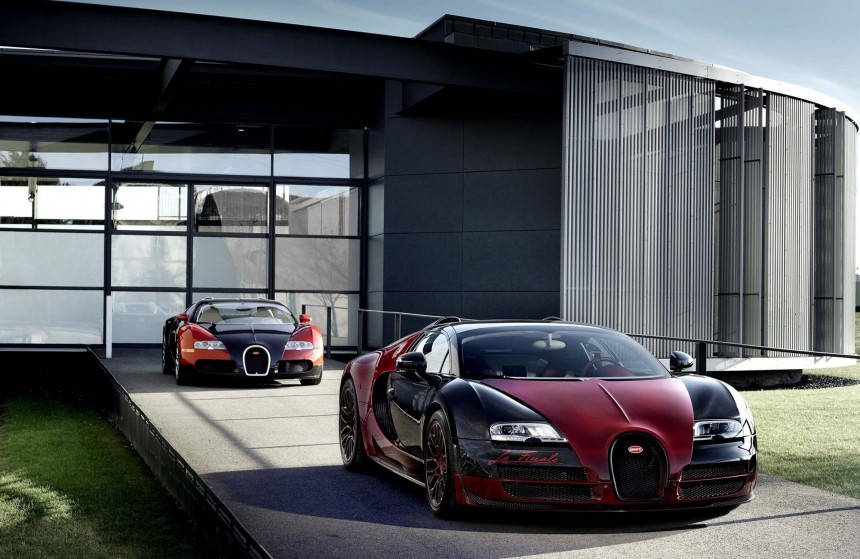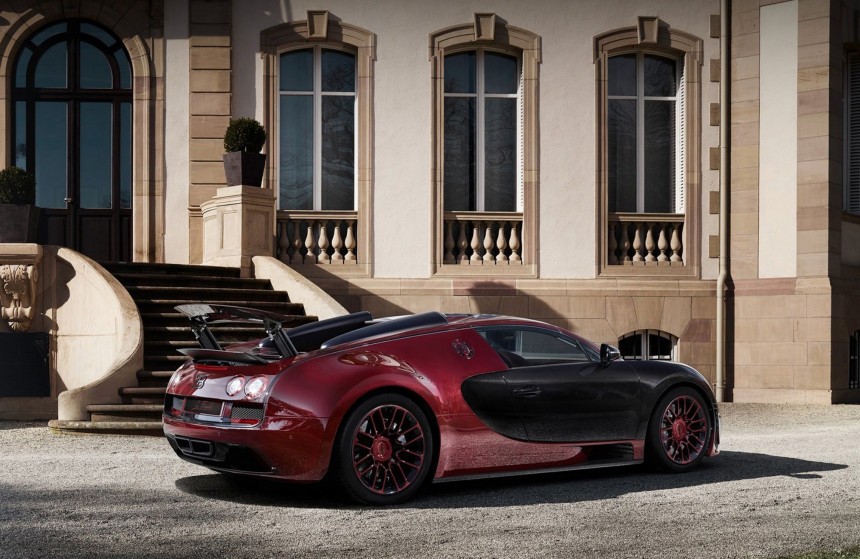Unveiled in 2012, the Grand Sport Vitesse may have been shrugged off as yet another pompously-named variant of a million-dollar hypercar. The naysayers couldn’t have been more in the wrong because the Veyron 16.4 Grand Sport Vitesse still is the world’s fastest series-production roadster.
But first, what’s in a name? As you’re well aware, 16.4 stands for 16 cylinders and no fewer than four turbochargers. Grand Sport stands for the open-top body style, unveiled at the 2008 Pebble Beach Concours d’Elegance. Rather than a soft top, Bugatti went for a targa-style top and plenty of reinforcements to compensate for the lack of a fixed-head roof.
Vitesse is the French word for speed, referencing this variant’s record-breaking top speed. The Grand Sport Vitesse can be nicely summed up as the open-top sibling of the fixed-head Super Sport. Revealed at the 2012 Geneva Motor Show, the Grand Sport Vitesse numbers 92 examples. By comparison, the Super Sport ended production after 48 units were made.
The Grand Sport totaled 58 copies, and the Veyron 16.4 is the most numerous of the bunch at 252 units, bringing the grand total to 450 cars. A year after its debut, a bone-stock Grand Sport Vitesse cemented Bugatti’s place in the world of hypercars by clocking 408.84 kilometers per hour in a straight line. That’s 254 miles per hour, and the record still holds today.
To celebrate the fastest series-production roadster ever produced, the Molsheim-based automaker offered a special edition of eight units, dubbed WRC for World Record Car. It originally retailed at €1.99 million, which is roughly €2.37 million adjusted for inflation, or $2.45 million.
Other notable special editions include the Type 37A-inspired Le Ciel Californien, the 1 of 1, and La Finale. Bugatti, which flaunts a tremendous racing legacy, also produced a series of Grand Sport Vitesse models dedicated to racing legends. Six models limited to three vehicles each, to be more precise, of which the Jean-Pierre Wimille edition really stands out.
Les Legendes de Bugatti further celebrate Black Bess, Meo Costantini, Rembrandt Bugatti, Jean Bugatti, and Ettore Bugatti. All six models are said to have sold out immediately after their unveiling, but we all know that Bugatti had sold them before their public reveals to well-to-do customers.
The Veyron 16.4 Grand Sport makes do with 1,001 ps, a figure that converts to 987 mechanical horsepower. The Grand Sport Vitesse levels up to 1,200 metric ponies, and the secret to this improvement is pretty straightforward: larger turbos and better cooling. From a visual standpoint, the wide air intakes up front make this variant hard to miss. The bottom air slot extends sidewards into the wheel wells, and out back, the central twin-pipe exhaust system is complemented by a double diffuser and a roof edge spoiler.
Another telltale of the Grand Sport Vitesse is the bodywork, produced entirely from carbon. Bugatti couldn’t pass up the opportunity to offer a clear finish for the carbon fiber. Unlike the Super Sport, the Grand Sport Vitesse also rocks a couple of air scoops on each side of the engine cover. In addition to feeding the W16 lump, these scoops offer rollover protection.
The roof module is produced from lightweight polycarbonate, and the reinforcements brought to the chassis and passenger cell resulted in torsional rigidity of 22,000 Nm per degree. The monocoque was reinforced around the side skirts and transmission tunnel, and Bugatti further stiffened the B pillars with carbon supports. The doors of the Grand Sport Vitesse integrate longitudinal supports with pins that passed the load from the A pillars to the B pillars in the event of an accident, reducing impact force.
From a mechanical standpoint, Bugatti strengthened powertrain components such as the gearing of the dual-clutch transmission. The French automaker also retuned the chassis, along with the electronic stability program, the Michelin-supplied rubber, as well as the oversized brakes.
Limited to 375 kilometers per hour (233 miles per hour) with the roof down, the Grand Sport Vitesse is capable of hitting 410 kph (255 mph) with it up. By comparison, the preceding Veyron 16.4 Grand Sport hits 360 kilometers per hour (224 miles per hour) and 407 kph (253 mph), respectively.
“The internal noise and turbulence are reduced to a minimum thanks to the roof edge spoiler and an elaborately designed wind deflector,” explains Christophe Piochon, the French automaker’s president. “Even at top speeds of over 200 kph (124 mph), the passengers can still hold a conversation with the top down. This was us catering to a fundamental customer wish.”
Vitesse is the French word for speed, referencing this variant’s record-breaking top speed. The Grand Sport Vitesse can be nicely summed up as the open-top sibling of the fixed-head Super Sport. Revealed at the 2012 Geneva Motor Show, the Grand Sport Vitesse numbers 92 examples. By comparison, the Super Sport ended production after 48 units were made.
The Grand Sport totaled 58 copies, and the Veyron 16.4 is the most numerous of the bunch at 252 units, bringing the grand total to 450 cars. A year after its debut, a bone-stock Grand Sport Vitesse cemented Bugatti’s place in the world of hypercars by clocking 408.84 kilometers per hour in a straight line. That’s 254 miles per hour, and the record still holds today.
To celebrate the fastest series-production roadster ever produced, the Molsheim-based automaker offered a special edition of eight units, dubbed WRC for World Record Car. It originally retailed at €1.99 million, which is roughly €2.37 million adjusted for inflation, or $2.45 million.
Les Legendes de Bugatti further celebrate Black Bess, Meo Costantini, Rembrandt Bugatti, Jean Bugatti, and Ettore Bugatti. All six models are said to have sold out immediately after their unveiling, but we all know that Bugatti had sold them before their public reveals to well-to-do customers.
The Veyron 16.4 Grand Sport makes do with 1,001 ps, a figure that converts to 987 mechanical horsepower. The Grand Sport Vitesse levels up to 1,200 metric ponies, and the secret to this improvement is pretty straightforward: larger turbos and better cooling. From a visual standpoint, the wide air intakes up front make this variant hard to miss. The bottom air slot extends sidewards into the wheel wells, and out back, the central twin-pipe exhaust system is complemented by a double diffuser and a roof edge spoiler.
Another telltale of the Grand Sport Vitesse is the bodywork, produced entirely from carbon. Bugatti couldn’t pass up the opportunity to offer a clear finish for the carbon fiber. Unlike the Super Sport, the Grand Sport Vitesse also rocks a couple of air scoops on each side of the engine cover. In addition to feeding the W16 lump, these scoops offer rollover protection.
From a mechanical standpoint, Bugatti strengthened powertrain components such as the gearing of the dual-clutch transmission. The French automaker also retuned the chassis, along with the electronic stability program, the Michelin-supplied rubber, as well as the oversized brakes.
Limited to 375 kilometers per hour (233 miles per hour) with the roof down, the Grand Sport Vitesse is capable of hitting 410 kph (255 mph) with it up. By comparison, the preceding Veyron 16.4 Grand Sport hits 360 kilometers per hour (224 miles per hour) and 407 kph (253 mph), respectively.
“The internal noise and turbulence are reduced to a minimum thanks to the roof edge spoiler and an elaborately designed wind deflector,” explains Christophe Piochon, the French automaker’s president. “Even at top speeds of over 200 kph (124 mph), the passengers can still hold a conversation with the top down. This was us catering to a fundamental customer wish.”



















